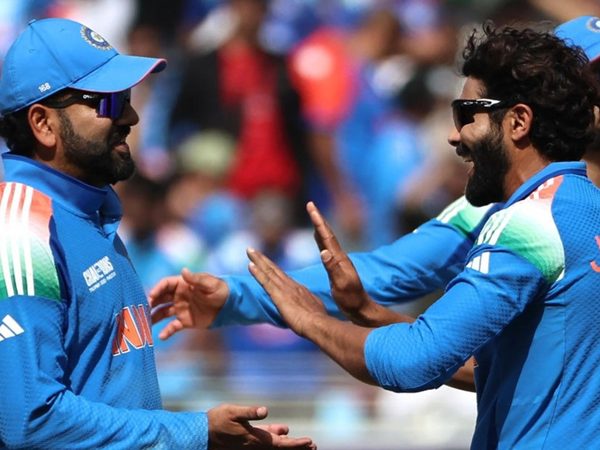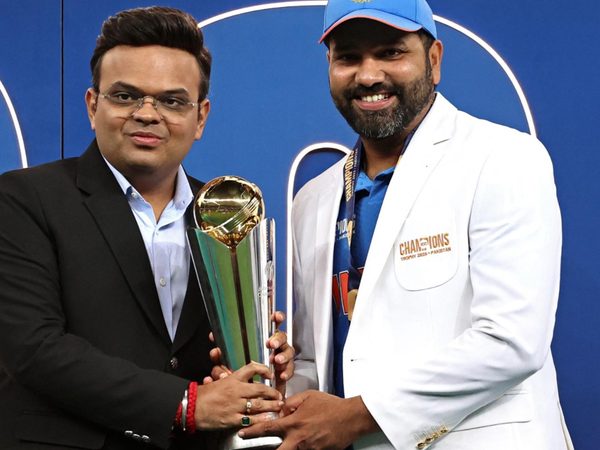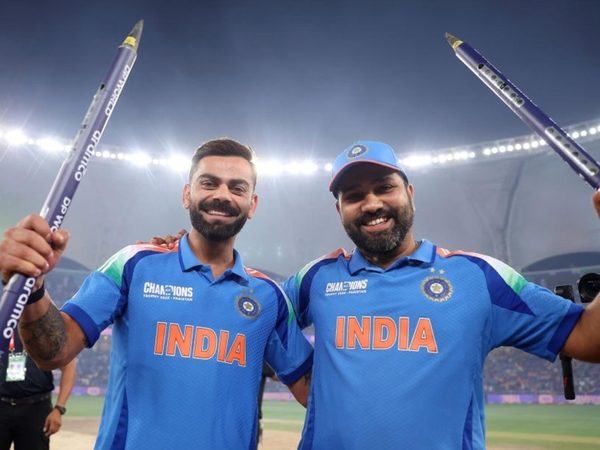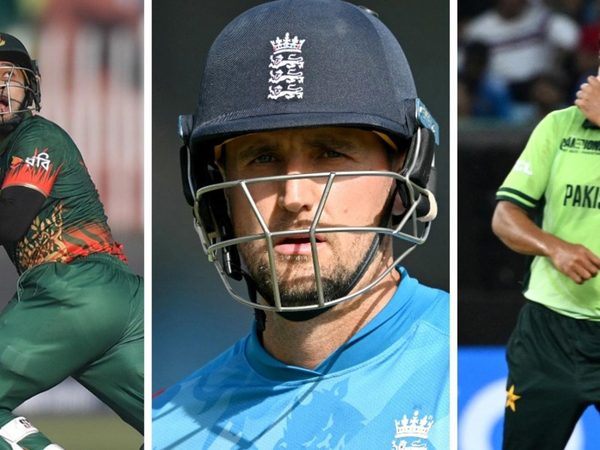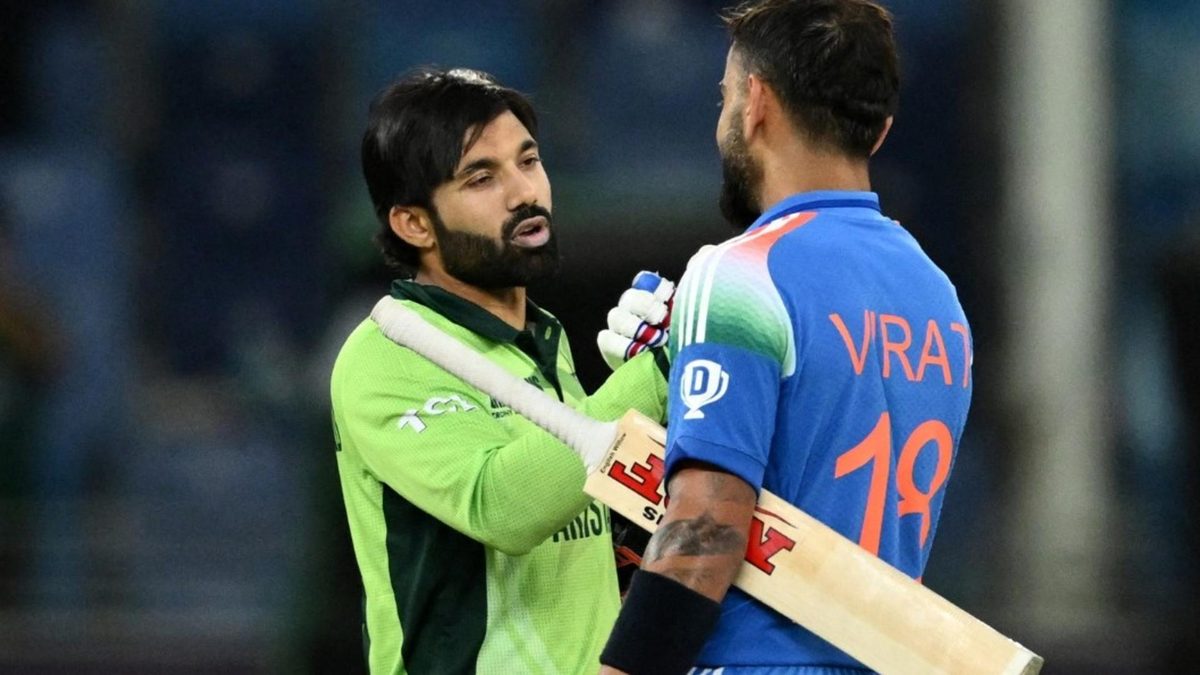
For the longest time, India versus Pakistan was a hotly-contested ODI rivalry. Today, it’s far from being a real contest. Aadya Sharma looks at the on-field degradation of a historic battle, and the desperate attempt to keep it relevant and marketable.
As I made my way to the living room, stealing a sniff of the freshly buttered popcorn bucket in my hands, I looked around at the occupants of the room. There were barely any eyeballs on the blue-and-green figure on the screen. No one took much notice of Mohammad Rizwan ambling along for a single. Axar Patel went back to his delivery mark without comment. There might as well have been a screen saver running inside the black frame.
We’d been discussing plans for Sunday on and off, with little real commitment. It was the same group, or a part of it, that I’d watched the 2017 clash of the same tournament. Back then, each one had religiously put on the India kits in support. In some way, it was a call-back to a childhood tradition, a nostalgic nod to the time when excited heads filled up every inch in front of each vacant TV.
When Pakistan won, the groans reminded me of the 1990s and 2000s. But in the eight years since, Pakistan have not defeated India in an ODI.
That’s six matches across different multi-team events. All one-sided.
Naturally, the India-Pakistan rivalry is the byproduct of the two nations and their strained geopolitical relations. In cricketing terms, ever since the two first played a match against each other, the sport became a convenient feuding ground. War minus the shooting, and all that.
Nobody wanted to lose: the 12 consecutive drawn Tests between 1952 and 1978 (interspersed by the wars of ’65 and ’71) tell you that much.
Across the eighties, India and Pakistan grew into two ODI powerhouses, handing subcontinental administrators a reason to pivot power towards Asia. The BCCI and the Pakistan board united to play mutual tours. That, along with getting the other Asian nations on board, helped them draw the World Cup out of England for the first time in 1987.
There was considerable hype and demand, and the two cricketing entities kept their links tied: for those who remember, Sunil Gavaskar and Imran Khan did a Thums Up ad together. Months earlier, Javed Miandad had hit Chetan Sharma for a last-ball six to create one of the first memories of a lasting, engaging battle.
The two teams continued to have memorable, see-saw battles in ODIs, but World Cup matches gave it a bigger context. From the start of the 1987 World Cup, until the 2011 World Cup – the first and last co-hosted events starring India, India won 38 ODIs and Pakistan 54. India maintained the upper hand in World Cups, winning five out of five in that period. Pakistan kept the overall numbers up through bilaterals.
Despite Pakistan’s lopsided World Cup record, it still remained a rivalry, because matches between these two teams were contested quite often. Across the 1990s, India played Pakistan more than any other ODI team (45 times).
This, despite neither team visiting the other between 1989 and 1997.
Pakistan decided to boycott the 1989-90 Asia Cup in India, as well as the 1993 Hero Cup. Toronto emerged as a neutral venue from 1996.
It was all set to change with the 1999 Kargil War: tours across the border further reduced, but instead of dimming it, these spiked up the excitement further.
There were worries that their 1999 World Cup fixture, bang in the middle of the war, would turn Manchester into a boiling pot of fanatic minds. Eventually, out of the 21,000-strong crowd, there were three arrests and nine spectator ejections.
Soon after the 1999 War, the Toronto series was split in two: with India and Pakistan playing separate series against the West Indies.
By the turn of the millennium, the balance of power made a distinct shift. India became a better, and more consistent ODI team. Pakistan became a motley of stars, great on their day but scratchy and unreliable at other times.
Since the start of 2000, India have won 31 and lost 26 against Pakistan.
The 2004 goodwill tour brought them closer, and the mutual admiration seeped into the larger conscience thereafter. The Pakistan president took a liking for MS Dhoni’s haircut, Shoaib Akhtar got Bollywood offers, Shoaib Malik became India’s adopted son-in-law.
But the 2008 terrorist attacks in India, and the subsequent political standoff has meant that bilateral ties have been cut off completely, effectively ending a flourishing equation that was easy to relay on the cricket field. Pakistan’s players did not get any IPL contracts in 2009, and haven’t played since, pushing them further away from the Indian cricketing ecosystem.
But unlike the 1990s, fewer matches haven’t really helped keep the rivalry ignited. India have comfortably been the stronger ODI side, stretching their World Cup domination to 8-0.
In all their ODIs since the 2011 World Cup, India have won 11, Pakistan four. And barring Shahid Afridi’s 2014 Mirpur finish, there’s been little that’s come close to an ODI thriller.
In such a lop-sided scenario, 50-over face-offs, restricted to the World Cups and Asia Cups, are disparate and lacking real cricketing build-up to start with, with India’s domination making it a bleak match-up. It's difficult to forget how, in the lead-up to their World Cup clash two years ago, Babar Azam was asked repeatedly about how good Hyderabad's biryani was.
And it isn’t just the on-field lopsidedness. India dominates the cricketing landscape, taking big calls, enjoying influence and rarely breaking its stance. Pakistan travelled to India for the 2023 World Cup, but failed in their desperate bid to make them visit their country for the Champions Trophy. In the end, the sight of a host nation playing its matches at a neutral venue told you where the power lay. The blueprint of this was laid at the 2023 Asia Cup.
The manner of defeat made it clear there existed no rivalry anymore.
For those on the business side of things, this is a serious obstacle. For long, the contest played into the hands of the packaging of India versus Pakistan. There’s still the sway of money: according to the Business Standard, for a ten-second match ad slot, companies were willing to pump out INR 50 lakh, three times the going rate for an IPL match.
India and Pakistan, without fail, are stacked in the same group to ensure at least one face-off, and are as good as pitted together for a second time at the Asia Cup. But it’s no longer the biggest crowd puller: at the 2023 ODI World Cup, the India-Australia final was the most-watched ICC match ever, and three other India matches at the same tournament had a higher digital peak for concurrent viewers: the bland game in Ahmedabad ensured there was never a high point of excitement.
2023 ODI World Cup: Highest digital peak concurrency on Disney+ Hotstar
| Match | Peak concurrent viewers | |
| 1 | India v Australia (final) | 59 million |
| 2 | India v New Zealand (semi-final) | 53 million |
| 3 | India v South Africa | 44 million |
| 4 | India v New Zealand | 43 million |
| 5 | India v Pakistan | 35 million |
The eyeballs on these games will continue: from ad campaigns to live screenings, bloated ticket prices and whatnot, there will be every attempt to keep milking this cash cow. But the on-field imbalance will eventually peter out interest levels. It’s already far from being “the contest of the tournament”, a much-used tagline in the past.
Television ads in India, historically tightly interwoven with India-Pakistan broadcasts, have moved away from hyping up the clashes. It’s the subtle mocking that follows, combined with the extolling of Virat Kohli, by far the most marketable entity of an India match. In the Indian media, hypernationalism takes over, tapping further into the contrast. Pakistan’s experts, left with little to fight, have now resorted to loud and long tirades.
There are still some things to look forward to: Shaheen against the top order, Kohli against the pace attack, Bumrah when he’s playing – but these at best make for exciting mini-contests that wear off when you zoom out to the bigger picture.
The T20I format, a more even contest, where the weaker team has a higher chance of causing an upset, is the best bet to keep it a level field. It started off with two nailbiters in 2007, but India have had an advantage since: nine wins versus three. The last two T20 World Cup matches between the two sides were still closely fought, and Pakistan’s 10-wicket win in the third-to-last had its own highwire drama.
Again, it remains to be seen if these sporadic twists are enough to keep the friction on. Three weeks ago, Netflix released a documentary titled: “India vs Pakistan: The Greatest Rivalry”, probably hoping to bite into the anticipation of a high-stakes Champions Trophy clash. The manner in which Sunday’s clash turned out, the post-colon phrasing wouldn’t be inaccurate to be replaced by “a glorified mismatch”.
India and Pakistan, two nations that carry a common history, and lineages that spread on either side, are going their separate ways in their cricketing trajectories.
It will take some serious counter-punching from Pakistan’s ODI team to bring it back to a certain standard. Or maybe, it will be up to T20Is to bring colour and parity. You’ll still see big posters and cheeky adverts, but it’s easy to admit that there are greater rivalries to appreciate than a forced match-up devoid of any real fight.
Follow Wisden for all cricket updates, including live scores, match stats, quizzes and more. Stay up to date with the latest cricket news, player updates, team standings, match highlights, video analysis and live match odds.

